Global and National Leaders to Explore Active Communities’ Impacts
Exploring if more active communities means more people will recreate and participate in community sport has long been a question for government, peak bodies and sport. Research shows globally that a shift started years ago with participants looking for more than just competitive and developmental opportunities within sports clubs. In Australia, the number one participation activity is running, which according to AusPlay attracts 4.17 million people (over 15), compared to Athletics Australia’s membership of approximately 60,000. Parkrun has nearly one million plus registered people in their organised weekly runs. Not forgetting an estimated one million plus who participate in fun runs, but are not members of an athletics club. So is the opportunity not being converted or do we need to seriously rethink how the industry is resourced and funded?
The Health Agenda for a More Active Nation
Health and Wellbeing is the main reason for being physically active, playing and recreating. Lyn Dean, Chief Executive of Wellbeing SA will explore how South Australia is understanding this desire to plan future facilities, policy and strategic partnerships.
Government Planning Should Develop Active Environments
Active community planning needs to understand community health and wellbeing and reflect this in the environments to encourage more people to play, recreate and participate in community sport.
Collaborative Approach to Local Space Activation
Exploring how State and Local Government collaborations can encourage physical activity locally through open space developments.
Collective Approach to Community Hubs
Sheffield Hallam University (UK) has developed a collective approach to Community Hubs to improve physical activity across the 0.5m people and encourage greater participation in community sport. The results are very encouraging.
